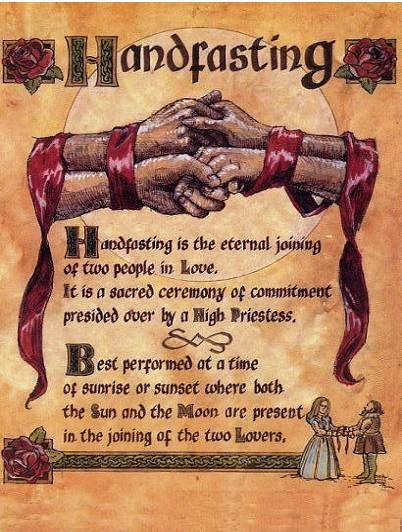
Norse (Germanic) Marriage
As it was the core of the family, marriage was the most important social institution in pagan Scandinavia. A wedding was thus an important transition not only for the couple but also for the families involved. A marriage was a legal contract with implications for, among other things, inheritance and property relations, while the wedding itself was the solemnization of a pact in which the families promised to help each other. Because of this the male head of the family had the final say in these matters. However it is clear from the sagas that the young couple also had a say since a good relationship between the spouses was crucial to the running of a farm. A wedding was a long and collective process subject to many ritual rules and culminating in the wedding feast itself. The procedures had to be followed for the divine powers to sanction the marriage and to avoid a bad marriage afterwards. However accounts in the sagas about the complicated individual emotions connected to a marriage tell us that things did not always work out between the spouses.
Freyja (1901) by Johannes Gehrts.
As a prelude to marriage the family of the groom sent the groom and several delegates to the family of the bride to propose. Here the date of the betrothal was set. This was the first legally binding step between the families, and the occasion was used to negotiate the inheritance and property relations of the couple as well as the dowry (heimanfylgja) and wedding present (mundr) from the groom's family. Those were the personal property of the bride. Usually the bride's family were less wealthy than the groom's, but in most cases the difference was not great. Thus the dowry was an investment by the bride's family that made it possible for her to marry into a more powerful family.[57] When an agreement on these matters had been reached, the deal was sealed at a feast.[58] These conditions were reserved for the dominating class of freeholders (bóndi/bœndr), as the remaining parts of the population, servants, thralls and freedmen were not free to act in these matters but were totally dependent on their master.
The wedding (brudlaup) was the most important single ritual in the process. It was the first public gathering of the two families and consisted of a feast that lasted for several days. Anything less than three days was considered paltry. The guests witnessed that the process had been followed correctly. The sources tell very little about how a wedding was related to the gods. It is known that the goddess Vár witnessed the couple's vows, that a depiction of Mjolnir could be placed in the lap of the bride asking Thor to bless her, and that Freyr and Freyja were often called upon in matters of love and marriage, but there is no suggestion of a worship ritual. From legal sources we know that leading the couple to the bridal couch was one of the central rituals. On the first night the couple was led to bed by witnesses carrying torches, which marked the difference between legal marital relations and a secret extra-marital relationship.
Source : Wikipedia
Handfasting
History
Handfasting is an ancient European ceremony of (temporary or permanent) betrothal or wedding that dates back to pre-Medieval times and usually involves the tying or binding of the hands of the bride and groom with a cord or ribbon.
Middle English hondfast, past participle of hondfesten 'to betroth', from Old Norse handfesta 'to strike a bargain, pledge', itself from hönd 'hand' + festa 'to fasten, fix, affirm' (compare see past- in Indo-European roots).
A handfasting is an old Pagan custom, dating back to the time of the ancient Celts. A handfasting was originally more like an engagement period, where two people would declare a binding union between themselves for a year and a day. The original handfasting was a trial marriage. It gave the couple the chance to see if they could survive marriage to each other. After a year goes by (a handfasting was once believed to last a year and a day), the couple could either split as if they had never been married or could decide to enter permanently into marriage.
Today, Pagans have embraced handfasting as a part of their wedding ceremony. A handfasting can either be a legal marriage (depending on state law), or a commitment for "as long as love shall last." A handfasting ceremony can be tailor made to suit the couple.
The Handfasting Ceremony
There are many variations of the traditional handfasting. After the bride and groom both declare their intent to enter into this union, the hands of the couple are clasped and fastened together with a cord or cords just before, just after, or during their vows are made to one another. The wrapping of the cord forms an infinity symbol. The handfasting knot that is tied is a symbolic representation of oneness between the couple. In a show of unity, they become bound to each other.
The Cords
Each Pagan path has different decrees concerning the color, length, type and of number of cords used to handfast the couple. One custom may have the couple facing each other, binding both pairs of hands of the bride and groom. Another custom is to have only the right hands, and another one of each right and left. There are many variations of the handfasting rite. It all depends on the bride, groom, and the High Priest/Priestess whom they chose to preside over their wedding ceremony.
The handfasting ritual is a beautiful, magical rite of passage. Many non-Pagan couples are adopting this old custom, much like when couples borrow from other traditions to craft their own ceremony to match their distinctive personalities.
